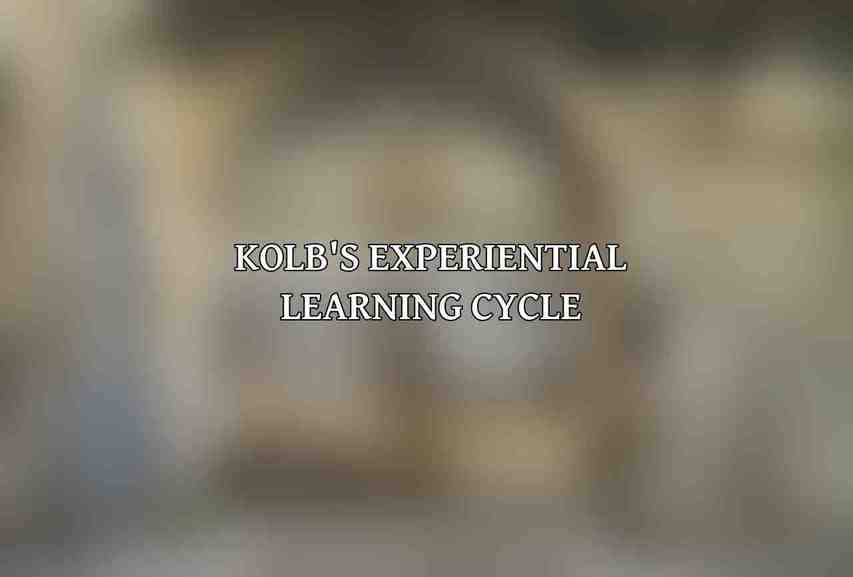When creating content for online courses, it is crucial to consider instructional design principles that enhance engagement. Two key frameworks that can guide course development are Bloom’s Taxonomy of Cognitive Objectives and Kolb’s Experiential Learning Cycle.
Bloom’s Taxonomy of Cognitive Objectives:
- Knowledge: Focusing on recalling information.
- Comprehension: Understanding concepts.
- Application: Applying knowledge in new situations.
- Analysis: Breaking down information into parts.
- Synthesis: Combining parts into a whole.
- Evaluation: Judging the value of ideas.
Kolb’s Experiential Learning Cycle:

- Concrete Experience:“Learning is the process whereby knowledge is created through the transformation of experience.”
- Reflective Observation: Considering experiences from different perspectives.
- Abstract Conceptualization: Forming concepts based on observations.
- Active Experimentation: Applying new concepts in real-world situations.
Moreover, understanding the principles of Constructivism vs. Behaviorism is essential. While constructivism emphasizes learner-centered and active learning approaches, behaviorism focuses on instructor-centered and passive learning methods. Implementing strategies that promote knowledge construction through interactions can significantly enhance engagement.
Multimedia Integration for Engagement
Incorporating multimedia elements plays a vital role in creating engaging online course content. Utilizing a variety of visuals, audio components, and interactive elements can cater to different learning styles and keep learners actively involved throughout the course.
Visuals:
- Including images, diagrams, infographics, and videos can help illustrate complex concepts effectively.
Audio:
- Integrating lectures, podcasts, and music can provide auditory reinforcement of course content.
Interactive elements:
- Incorporating quizzes, simulations, and games can make learning more interactive and stimulating for students.
Tools for multimedia integration:
- PowerPoint: Ideal for creating visually appealing slide decks.
- Canva: Great for designing graphics and visuals.
- Google Slides: Collaborative platform for creating presentations.
- Adobe Premiere Pro: Advanced video editing software for creating engaging video content.
Student Engagement Strategies

Enhancing student engagement in online courses requires the implementation of various strategies that cater to diverse learning preferences and motivations.
Gamification:
- Utilizing elements such as leaderboards, badges, and rewards can incentivize students to actively participate and progress in the course.
Social Learning:
- Encouraging discussion forums, peer reviews, and collaborative projects fosters a sense of community and interaction among learners.
Personalized Learning:
- Employing adaptive learning software and self-paced content accommodates individual learning paces and preferences.
Storytelling:
- Integrating narratives, case studies, and personal anecdotes can make course content more relatable and engaging for students.
Microlearning:
- Breaking down content into short, digestible fragments helps prevent cognitive overload and enhances retention of information.
Stay tuned for the continuation of this article in the next part…
Frequently Asked Questions
What are the key elements of engaging content for online courses?
Key elements of engaging content for online courses include clear learning objectives, interactive elements such as quizzes and discussions, multimedia like videos and graphics, and personalized learning experiences.
How can I keep online course content interesting and relevant?
To keep online course content interesting and relevant, continuously update the material to reflect current trends and advancements in the subject matter, incorporate real-life examples and case studies, and encourage active participation from learners.
What are some tips for creating visually appealing content for online courses?
Tips for creating visually appealing content for online courses include using a consistent color scheme, incorporating images and videos to break up text, using easy-to-read fonts, and creating interactive elements to engage learners.
How can I ensure that my online course content is accessible to all learners?
To ensure that online course content is accessible to all learners, make sure to provide text alternatives for images and videos, utilize closed captioning for videos, provide transcripts for audio content, and use accessible design principles.
What strategies can I use to promote engagement and interaction in online courses?
Strategies to promote engagement and interaction in online courses include creating discussion forums for students to share ideas and ask questions, providing regular feedback on assignments, incorporating group projects and collaborative activities, and hosting live webinars or Q&A sessions.
wp:html –>
/wp:html –>
wp:html –>
/wp:html –>
